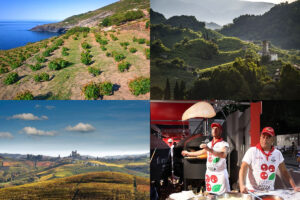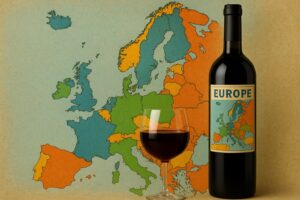With a record increase of 13% in 2008, Italian products based on the Mediterranean diet have beaten the crisis and confirm the trust abroad that has been conquered by Italian food. The Italian agricultural organization Coldiretti recently revealed the latest numbers based on data from Istat for 2008: pasta acquisitions grew by 28%, canned tomatoes by 20%, fruit 14%, wine 5%, and olive oil up by 2%.
According to Coldiretti, it is the added value of the guarantee of quality and health safety that is conquering a growing appreciation around the world and prompting forecasts of even more growth in 2009.
Bread, pasta, fruit, vegetables, olive oil, and wine, all traditionally consumed at Italian mealtime have, in fact, allowed Italians to hold the record for longevity in Europe with an average lifespan of 78.6 years for men and 84.1 years for women. And recent data published in the ‘British Medical Journal’ revealed that the Mediterranean diet also reduces the risk of Parkinson’s and Alzheimer’s disease by 13%, cardiovascular problems by 9%, and cancer by 6%.
These facts have pushed the European Commission and Parliament as well to make efforts to safeguard the Mediterranean diet by backing the request to declare it a UNESCO world heritage. UNESCO’s acceptance, which is set to be decided in September 2009, would create a reaction to recuperate the healthy eating habits of Mediterranean countries. It is a goal that has an extraordinarily important value for Italy because it is the emblem of this type of cuisine and has the most profound roots in the culture of food as well as the highest production in Europe of fruits, vegetables, wine, pasta, and follows only behind Spain in olive oil production.
Pasta, with a 27% increase in exports, has become the leader of this boom. Over two thirds of these exports were destined for other European countries, while the United States ate up 9% of total exports. Tomato preserves and sauces followed with a 20% increase. And 2008 also marked an important year for Italian fruit, registering an increase of 14% for exports of Italian kiwis to China (where fruit consumption has increased from 40 to 70 kilos per person over the past ten years). And Coldiretti points out that the opening up of this great Asian nation represents an enormous opportunity for kiwis (Italy being the top exporter worldwide), as well as opening the way for other fruits and vegetables that have been blocked by the presumed fear of the spread of dangerous insects like the Mediterranean fruit fly.
2008 closed with exports of Italian wine reaching, for the first time ever, a total of 3.5 billion euros (+5%) thanks, above all, to demand from the United States and Germany, though the distribution of Italian wine in emerging countries is also showing strong signs of growth. 2008 also marked the year that Italy took first place position for wine production, surpassing its long time rival France. After many years, the 2008 grape harvest finally permitted the historic step ahead of France with a total production of 45 million hectoliters compared to 44 million hectoliters.
There was also a net qualitative increase last year with 60% of wines being produced under the DOCG, DOC, IGT certifications. There is now a total of 477 wines of controlled origin denomination in Italy, 316 of which are DOC, 41 are DOCG and 120 are IGT.
Regardless of the not so favorable euro-dollar exchange, the U.S. still revealed that one third of all bottles of wine consumed were of Italian origin, reconfirming its first place position ahead of Australia and France. The U.S. also registered a 2% increase in Italian olive oil imports.
The successful results abroad of the Mediterranean diet has pulled along the entire Italian food market, which noted an overall increase in the value of exports of 10%, and is the only sector that grew among the top Italian exporting sectors like design, fashion, and autos that, which all remained stagnant in 2008.
As for internal consumption, Italian food product consumption increased only slightly by 0.9%, while a decrease in clothing acquisitions fell by 1.6%, and autos a whopping 13.4% in 2008 according to Istat and Acea data.
Italy’s Mediterranean Diet Export Boom Numbers (in Millions)
(Product, Value 2007, Value 2008, -/+%)
Pasta, 1,253, 1,705, +27%
Tomato preserves, 796, 988, +20%
Fruit, 2,116, 2,376, +14%
Wine, 2.859, 2,981 +5%
Olive oil, 904, 922, +2%
Total, 7,928, 8,973, +13%
Source: elaborations by Coldiretti on Istat data relative to 30 October 2008
Italy’s Export Numbers for Top Industries (in Millions)
(Product, Value 2007, Value 2008, -/+%)
Food & Agriculture, 5,310,3 5,840,1, + 10 %
Auto 13,103, 13,035, - 0,5 %
Clothing and Fabric, 23,528, 23,420, -0,5 %
Furnishing & Furniture, 7,744, 7,727, -0,2%
Source: elaborations by Coldiretti on Istat data relative to 30 October 2008
Retail Sales Values
Product, +/-%
Food & Agriculture +1,5 %
Auto (*) -13,4 %
Clothing -1,6%
Furnishing & Furniture -1,2%
(*) number of vehicles matriculated in Italy in 2008 according to Acea
Source: elaborations by Coldiretti on Istat data relative to 30 November 2008
Copyright © 2000/2025
Contatti: info@winenews.it
Seguici anche su Twitter: @WineNewsIt
Seguici anche su Facebook: @winenewsit
Questo articolo è tratto dall'archivio di WineNews - Tutti i diritti riservati - Copyright © 2000/2025








































































































































































































